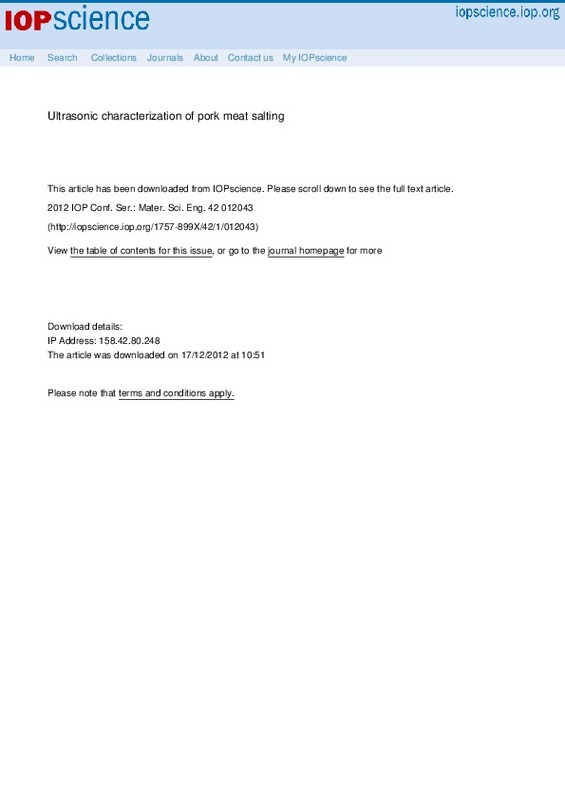JavaScript is disabled for your browser. Some features of this site may not work without it.
Buscar en RiuNet
Listar
Mi cuenta
Estadísticas
Ayuda RiuNet
Admin. UPV
Ultrasonic characterization of pork meat salting
Mostrar el registro sencillo del ítem
Ficheros en el ítem
| dc.contributor.author | García Pérez, José Vicente
|
es_ES |
| dc.contributor.author | PRADOS PEDRAZA, MARTA DE
|
es_ES |
| dc.contributor.author | Pérez-Muelas Picón, Mª Nieves
|
es_ES |
| dc.contributor.author | Cárcel Carrión, Juan Andrés
|
es_ES |
| dc.contributor.author | Benedito Fort, José Javier
|
es_ES |
| dc.date.accessioned | 2013-07-01T07:30:54Z | |
| dc.date.available | 2013-07-01T07:30:54Z | |
| dc.date.issued | 2012 | |
| dc.identifier.issn | 1757-8981 | |
| dc.identifier.uri | http://hdl.handle.net/10251/30296 | |
| dc.description.abstract | [EN] Salting process plays a key role in the preservation and quality of dry-cured meat products. Therefore, an adequate monitoring of salt content during salting is necessary to reach high quality products. Thus, the main objective of this work was to test the ability of low intensity ultrasound to monitor the salting process of pork meat. Cylindrical samples (diameter 36 mm, height 60±10 mm) of Biceps femoris were salted (brine 20% NaCl, w/w) at 2 ºC for 1, 2, 4 and 7 days. During salting and at each experimental time, three cylinders were taken in order to measure the ultrasonic velocity at 2 ºC. Afterwards, the cylinders were split in three sections (height 20 mm), measuring again the ultrasonic velocity and determining the salt and the moisture content by AOAC standards. In the whole cylinders, moisture content was reduced from 763 (g/kg sample) in fresh samples to 723 (g/kg sample) in samples salted for 7 days, while the maximum salt gain was 37.3 (g/kg sample). Although, moisture and salt contents up to 673 and 118 (g/kg sample) were reached in the sections of meat cylinders, respectively. During salting, the ultrasonic velocity increased due to salt gain and water loss. Thus, significant (p<0.05) linear relationships were found between the ultrasonic velocity and the salt (R2=0.975) and moisture (R2=0.863) contents. In addition, the change of the ultrasonic velocity with the increase of the salt content showed a good agreement with the Kinsler equation. Therefore, low intensity ultrasound emerges as a potential technique to monitor, in a non destructive way, the meat salting processes carried out in the food industry. | es_ES |
| dc.language | Inglés | es_ES |
| dc.publisher | IOP Publishing: Conference Series | es_ES |
| dc.relation.ispartof | IOP: Materials Science and Engineering | es_ES |
| dc.rights | Reconocimiento (by) | es_ES |
| dc.subject.classification | TECNOLOGIA DE ALIMENTOS | es_ES |
| dc.title | Ultrasonic characterization of pork meat salting | es_ES |
| dc.type | Artículo | es_ES |
| dc.identifier.doi | 10.1088/1757-899X/42/1/012043 | |
| dc.rights.accessRights | Abierto | es_ES |
| dc.contributor.affiliation | Universitat Politècnica de València. Departamento de Tecnología de Alimentos - Departament de Tecnologia d'Aliments | es_ES |
| dc.description.bibliographicCitation | García Pérez, JV.; Prados Pedraza, MD.; Pérez-Muelas Picón, MN.; Carcel Carrión, JA.; Benedito Fort, JJ. (2012). Ultrasonic characterization of pork meat salting. IOP: Materials Science and Engineering. 42:1-4. doi:10.1088/1757-899X/42/1/012043 | es_ES |
| dc.description.accrualMethod | S | es_ES |
| dc.relation.publisherversion | http://dx.doi.org/10.1088/1757-899X/42/1/012043 | es_ES |
| dc.description.upvformatpinicio | 1 | es_ES |
| dc.description.upvformatpfin | 4 | es_ES |
| dc.type.version | info:eu-repo/semantics/publishedVersion | es_ES |
| dc.description.volume | 42 | es_ES |
| dc.relation.senia | 240762 | |
| dc.identifier.eissn | 1757-899X |








